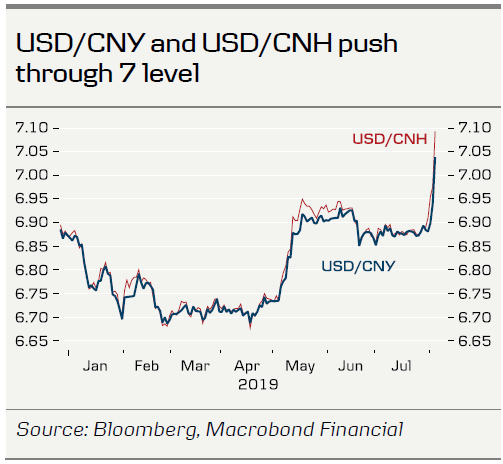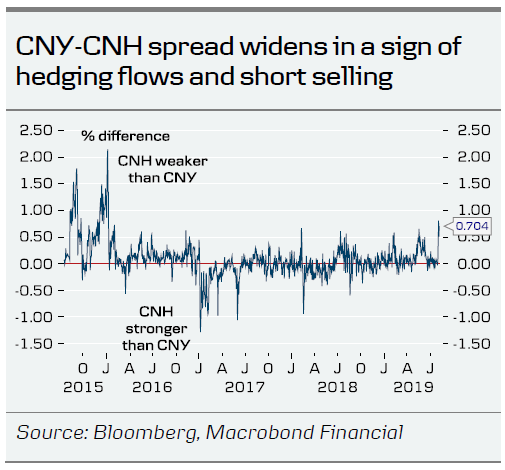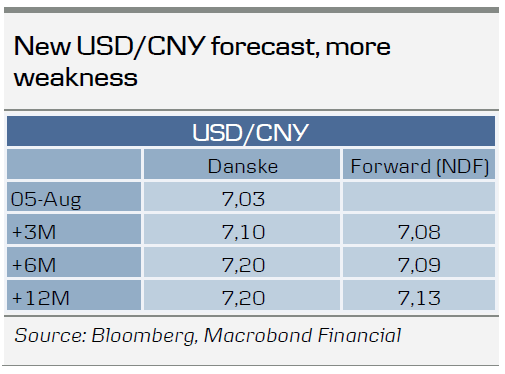- The recent escalation in the trade war pushed USD/CNY above the psychological level of 7.0 on Monday.
- The likelihood of a trade deal on this side of the US election is decreasing and the risk of further escalation is increasing. We now forecast a move in USD/CNY to 7.20 in 6M and 12M.
- We do not expect China to turn to devaluation as a weapon in the trade war. In our view, the costs would be too high and China wants to be seen as ‘responsible’.
- Hedging CNY receivables still makes sense, though, as a ‘fire insurance’ against a worst-case trade war scenario, in which Trump adds more tariffs and tightens export controls on China.
USD/CNY moves above 7, what’s behind the move?
The lid came off USD/CNY and USD/CNH overnight, as the People’s Bank of China (PBoC) set the fixing above 6.90, the weakest level since November 2018. USD/CNH immediately jumped through the 7.0 level, triggering stops that took the cross very quickly above 7.10 before settling down around 7.08-7.09.
The CNH weakened a lot more than the CNY, suggesting that the move is driven by selling in the CNH market. This market is typically used more by companies for hedging as well as by investors taking speculative positions on the CNY. The CNY-CNH spread is now at its widest spread since the market turmoil in 2015-16, underlining the selling pressure in the CNH market.
Wasn’t the 7-level a ‘red line’ for PBoC? Not really
PBoC governor Yi Gang has said for some time that ‘no specific yuan level’ was important, sending a clear hint that there was nothing magical about 7. He added in June that ‘there is obviously a link between the trade war and the movements of renminbi’. Yi Gang has also stressed that the yuan level is determined by markets and that yuan flexibility was good for the economy as it acts as a stabiliser.
That the USD/CNY could break 7 today was apparently not completely unexpected by the PBoC. Very shortly after the move, the central bank issued a statement saying that the fall in the renminbi was ‘influenced by the unilateralism and the protectionist measures’ as well as expectations of more US tariffs on Chinese goods adding that ‘the drop reflects the market’s demand-supply relationship and the fluctuation of international exchange rate market’. PBoC also underlined that the ‘PBoC has experience, confidence and capacity to maintain [the] renminbi exchange rate at a reasonably stable equilibrium’.
Could China use the currency as a weapon and devalue? Not likely
The uncertainty coming up when the trade war escalates and China has run out of US goods on which to put tariffs is whether the leadership will turn to a devaluation to hurt the US.
We doubt very much that this will be the case and the PBoC’s Governor underlined this message as well during Monday, when he said China would not use the CNY as a tool in the trade war.
First, a devaluation could very quickly backfire. When markets – and Chinese households – feared a devaluation in 2015/16, it led to significant capital outflow pressure, which China struggled to contain. It eventually succeeded but it does not want to be in this situation again.
Second, China wants to be seen as a responsible economic player on the global scene and a devaluation would hurt not only the US but also China’s trade partners in the rest of Asia and in Europe. At a time when China is looking to improve relationships with other countries to compensate for the confrontation with the US, it would be self-defeating to devalue. China also often underlines that it took global responsibility during the Asian crisis, when the Chinese economy was under significant pressure from the sharp depreciations of the countries around it as well as the falling demand from the same countries. China chose not to follow suit and devalue the currency and lived with the pain of an appreciation versus many of its Asian trade partners.
Third, for the past couple of years, China has stressed that it has shifted to an FX regime of a market-based currency, in which the currency is managed against a basket of currencies to keep it in line with an equilibrium that reflects fundamentals. So in the short term, the market is allowed to determine the currency but if the market takes it too far away from ‘fundamentals’, the PBoC will intervene. With tariffs put on China, it shifts the equilibrium rate for USD/CNY higher and as such requires no intervention. However, a devaluation would be a break with this regime and China would lose considerable credibility in the system it is trying to build up.
Will the CNY weaken further? We expect so
While we do not look for a devaluation, we see a high probability that the market will weaken the CNY further over the coming year. With no deal in sight and a risk of further tariff hikes from Donald Trump, we believe the selling pressure will persist and we now look for USD/CNY to move to 7.20 in 6M and 12M (our previous 12M forecast was 6.8).
This is a bit more weakness than the forward market is pricing and hedging CNY receivables makes sense in this scenario, in our view. Regardless of expectations, hedging CNY income should also be seen as a ‘fire insurance’ against a further escalation of the trade war.
The depreciation of the CNY is a clear red flag for Trump underlined by a tweet from him on Monday afternoon saying ‘China dropped the price of their currency to an almost a historic low. It’s called “currency manipulation”. Are You listening Federal Reserve? This is a major violation, which will greatly weaken China over time!’ The tweet underscores the risk that Trump might react by adding even more tariffs on China.















